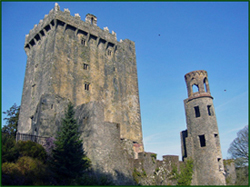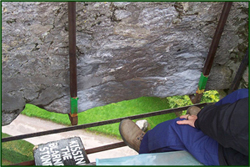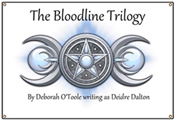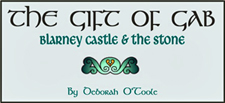 Blarney Castle is one of the
most famous buildings in Ireland, yet is perhaps better
known throughout the world as the home of the Blarney Stone.
The current castle is the third rendition of the structure.
The first was built from timber in the tenth century and
used as a hunting lodge, but was later replaced by an
edifice made of stones. In 1446, the third version of the
castle was built by the King of Munster, Dermot McCarthy,
the ruins of which can be seen today. The name of the castle
is taken from the Irish An blarna, which translates
to "the plain."
Blarney Castle is one of the
most famous buildings in Ireland, yet is perhaps better
known throughout the world as the home of the Blarney Stone.
The current castle is the third rendition of the structure.
The first was built from timber in the tenth century and
used as a hunting lodge, but was later replaced by an
edifice made of stones. In 1446, the third version of the
castle was built by the King of Munster, Dermot McCarthy,
the ruins of which can be seen today. The name of the castle
is taken from the Irish An blarna, which translates
to "the plain."
Other historians note that Queen Elizabeth I introduced the term "blarney" into the English language. She claimed the Irish had an eloquent gift for talk, "a pleasant manner of speaking which was intended to deceive without offending." Legend has it she dubbed Cormac McCarthy "Lord Blarney" because of his apparently effortless ability to talk with her, but at the same time never agreeing to her demands. The Tudor Queen would repeatedly order McCarthy to give his allegiance to her and while he agreed, he would never quite follow through with his promise.
Blarney Castle remained the stronghold of the McCarthy family until Oliver Cromwell arrived in 1646, a few years before the proclamation of the republican Commonwealth in England. Backed by cannon and soldiers, Cromwell sanctioned the massacre of the royalist garrison in Drogheda and then dispossessed many of the Irish by transferring their lands to Protestant administrators (the McCarthy's among them). When Charles II was crowned King of England fifteen years later, the McCarthy's were able to return to the their castle.
The McCarthy's were well known as generous patrons of Irish culture. They created the Bardic School at Blarney, which drew scholars from all over Ireland and other parts of the world. During the fifteenth century Blarney Castle was also renowned as the "Court of Poetry" where bards gathered to read their sonnets and other compositions, some of which have survived in original Irish form and various English translations. When the McCarthy's were in residence at the castle, there was always a bard on hand, serving the family as a poet, historian and musician.
However, some three decades after their triumphant return to Blarney Castle in 1679, the McCarthy's were stripped of their prominence following the Battle of the Boyne and were forced to vacate the castle again. It is said that a member of the McCarthy clan tossed the family silver into the nearby lake before leaving. Sir James Jefferyes, the Governor of Cork, purchased Blarney Castle in 1703. In the present day, the castle is managed by the Trustees of the Blarney Castle Estate.
The design of Blarney Castle encompassed a height of eighty-five feet, with walls as thick as eighteen feet at the base. The original intent of the castle was to provide defense from enemies in the day of Irish Kings and their battles, and for this reason the dwelling is sometimes referred to as a "keep." The structure was also built atop a small cliff, making it even more difficult for aggressors to penetrate. Spiral staircases lined the inside of the castle, their steep narrowness allowing only one person at a time across the width. Windows were also narrow, meant for ease of battlement but not for entrance. There was also a parapet connecting the towers of the castle, which permitted defenders to shoot oncoming invaders.
During the castle's illustrious history, it was also used as a comfortable place of residence and in fact was almost like a small town surrounded by walls of stone. Contained inside the walls was a chapel with a separate room that housed the various priests, as well as a "family" room, a banqueting hall, a sprawling kitchen, a room for the guards and a great hall from which other parts of the castle were accessible (such as the family quarters). Additional parts of the fortress included a kennel and a sentry, along with a dungeon that held prisoners, the guards on watch and several hidden passageways. When the McCarthy's occupied the castle, it was also home to a large retinue of knights and retainers.
The grounds of the castle were renowned for their stunning beauty, with the Blarney River running its course through the property. This lush magnificence is still evident today, with the woodlands set amongst one thousand acres and attracting more than 200,000 visitors each year from all over the world.





